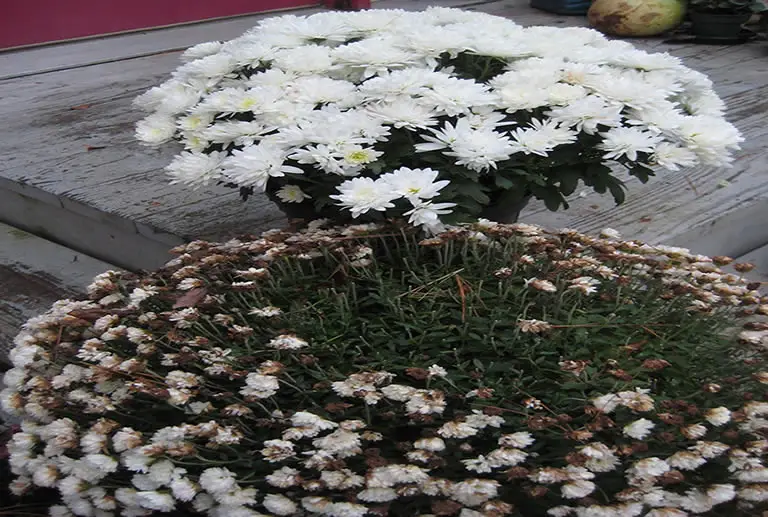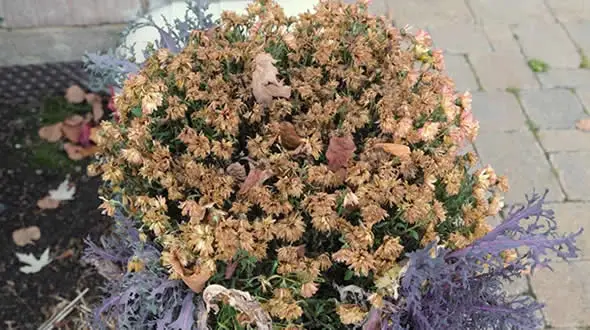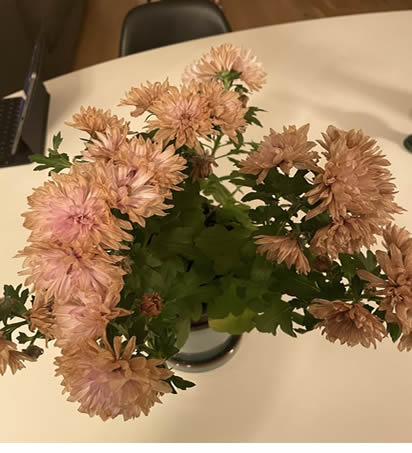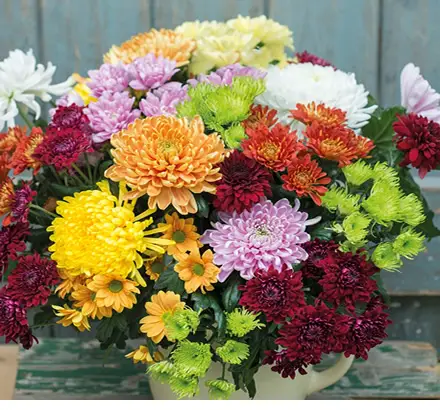How To Stop Mums Turning Brown & Fix Browning Plants

Chrysanthemums are beautiful flowering plants that are easy to grow and require very little attention. More commonly known as mums these beautiful fall flowering plants come in a variety of different colors and shapes. As they are easy to grow and easy to look after gardeners wonder why they sometimes see their mums turning brown. Here I look at the causes and cures for your mums turning brown.
Table of Contents
- Why Your Chrysanthemum Leaves Are Turning Brown
- How to revive mums that are dying
- Care tips for cultivating mums and avoiding mums turning brown
- Only grow outside in the correct climate zones
- Planting times should be observed
- Only use the correct type of soil
- Sunlight is important to mums
- A correct watering routine is essential for healthy growth & for preventing mums turning brown
- Be careful with the fertilizer
- Dealing with pets and diseases that can lead to chrysanthemum leaves turning brown
- Conclusion: How To Stop Mums Turning Brown & Save Plants That Are Already In Distress
Why Your Chrysanthemum Leaves Are Turning Brown
Why are my mums turning brown?
The most common cause for mums turning brown is adverse weather conditions.
Hail, lack of water or very heavy rain and early frost can turn the flowers of mums brown and even make them mushy.
Mum blooms will naturally turn brown and fall away when they have finished flowering.

There are steps you can take to prevent mums turning brown, such as covering the plants before forecasted adverse weather hits.
I will cover the basic care steps you need to follow to both prevent mums turning brown and to revive a dying plant that has already started to turn brown.
Chrysanthemums, sometimes called chrysanths and more commonly known as mums, originate in East Asia.
They are now also commonly grown naturally in northeastern Europe.
In America mums are grown as a fall plant for their beautiful flowers that bloom from late summer through fall.
There are hundreds of different varieties of mums that come in a range of different sizes with flowers in a variety of different colors and shapes.
Mums require rich soil that has good drainage and good air circulation.
They need full sunlight and don’t like shade much.
Chrysanthemums are easy to grow and just as easy to maintain.
However, they are very susceptible to developing problems when there are adverse weather conditions.
Mums will turn brown with adverse weather conditions.
As with many plants, early frost can cause serious problems for chrysanthemums as can heavy rain and hail.
In fact, any of these adverse weather conditions can actually turn mums brown, and make them mushy, literally overnight.
Although mums will turn brown if they are not watered sufficiently the opposite can also cause the same problems.
Too much watering, usually due to very heavy rainfall, also turns mums brown.
Be aware that mum blooms will begin to turn brown naturally and eventually fall off when they have finished their flowering cycle.
This is a gradual process and so seeing the occasional brown flower should not be a cause for concern.
If you find that your mums have turned brown overnight, or in a very short period of time, then then this is not due to a natural cause.
You will need to take steps to identify the problem and protect your plant.
How to revive mums that are dying
Mums are vibrant late blooming plants that offer a myriad of color to any environment.
If they start to turn brown you should act immediately to save the plant, as chrysanthemums will bounce back from even the most ferocious of weather attacks.
Heavily damaged mums can survive if you act quickly.
 Even mum plants that have been seriously damaged by bad weather can be cut back almost to ground level. They will grow back just as healthy as they were before the damage occurred.
Even mum plants that have been seriously damaged by bad weather can be cut back almost to ground level. They will grow back just as healthy as they were before the damage occurred.
If your mums are only slightly damaged and showing signs of occasional browning then you can cut away the brown flowers to encourage new growth.
Follow the steps laid out below to ensure the care routine for your chrysanthemums is correct.
Make any adjustments you need to your existing care routine and your mums should bounce back to full life.
How to stop mums turning brown the easy way
Browning of mums can be prevented as long as you take action before heavy rain, hail or frost arrives.
If early frost, heavy rain or hail is forecasted, then simply covering your plants with plastic tarp can be enough to protect them and prevent browning from occurring.
If you live in a climate zone that experiences a lot of frost you can use mum plants that are more frost-resistant.
There are varieties of chrysanthemums that have been specially cultivated, through selective breeding, to be better able to handle harsher weather conditions.
Be aware also that some varieties of mums are naturally brown like the Marjolein Brown.
Care tips for cultivating mums and avoiding mums turning brown
Below are some care tips to help you grow healthy mums and avoid the browning effect that is common.
Only grow outside in the correct climate zones
Mums grow best in climate zones 5 – 9 though some cultivated varieties will happily grow in zone 4.
Check your zone and our guide to zonal gardening to see if your location is ideal for growing mums.
Planting times should be observed
Late summer or very early fall is the best time to plant mums if you want a nice fall bloom.
Some gardeners will plant their mums in spring to give them a better chance of surviving the following winter.
This is unnecessary for potted plants.
Only use the correct type of soil
Mums make great house flowering plants either in hanging baskets or porch and deck pots.
They prefer rich soil that is filled with nutrients.
The soil should have good drainage.
If you are unsure of what soil to use simply use a soil that is recommended for vegetable growth.
This soil will have everything a mum plants needs for strong growth and healthy, colorful blooms.
Sunlight is important to mums
Mums require full sun to grow healthy and to bloom fully.
They do not grow well in the shade like some other plants. So avoid bunching them up together to the point that they are overcrowded and robbing parts of the plant of sunlight.
Also avoid placing them in overly shaded areas.
A correct watering routine is essential for healthy growth & for preventing mums turning brown
Although mums can tolerate a large amount of neglect they do need full sunlight and watering.
Mums have shallow roots systems, making them great for pots and baskets, but this means they need regular watering.
If you live in a climate zone that receives high heat or little rainfall you will need to water your plants regularly ensuring the soil stays somewhat moist.
In such conditions adding a layer of mulch at their base will help retain moisture and keep the soil cool thus excessive avoid evaporation.
Be careful with the fertilizer
As long as you plant your mums in the correct rich soil they will rarely require fertilizing.
A 6-2-4 or 4-2-3 fertilizer is best for mum plants. The fertilizer should be well diluted and applied at a rate of 1 pound per 100 square feet of garden bed.
Pruning can help keep chrysanthemum healthy and prevent mums turning brown
Although chrysanthemums require very little attention if you pinch off spent blooms you will find that you prolong the blooming period of your plant.
You will also help prevent the mums bloom from turning brown.
 Many mums growers will pinch the blooms back around the 4th of July.
Many mums growers will pinch the blooms back around the 4th of July.
This helps to encourage a more vigorous bloom before the first frost hits, though this of course depends on your location.
If you live in an area that experiences very warm and dry summers you may experience late blooming mums. The flowers will appear much later than they normally do in other climatic zones.
It is possible to actually mow your mums to ground level around early July if you find that you are experiencing a particularly hot summer.
Some gardeners mow their mums to the ground in early July regardless of the weather as this may encourage better and stronger blooms come fall.
When pruning a chrysanthemum plant it is best not to pinch your mums any later than 3 months prior to blooming.
As I outlined above only remove blooms after that if they start to turn brown.
Dealing with pets and diseases that can lead to chrysanthemum leaves turning brown
As you have seen mums do not turn brown due to either disease or pests but this does not mean they are not open to attacks from these things.
The diseases that most often affect mum plants are leaf spot, powdery mildew, and mosaic or stunt.
As I mentioned previously mums need plenty of sun and do not like the shade so try to avoid overcrowding plants if you have them in the ground or bunched up together in pots.
Likewise, you should avoid placing them in shady locations.
Not only will the lack of sun be a problem for plant growth but the shade will mean moisture tends to remain on the leaves longer than normal encouraging disease growth.
Mum pests include aphids, caterpillars, leafhoppers, leafminers, plant bugs, and spider mites all of which can be treated in the usual way.
I spray my plants with an organic pesticide once per year, usually around the time that pests tend to surface.
Conclusion: How To Stop Mums Turning Brown & Save Plants That Are Already In Distress
Mums will turn brown due to a lack of watering or an excess amount of water (usually from heavy rain), while hail can also be a factor.
However, early frost is the most common culprit for mums turning brown. They can also become mushy when subjected to frost.
Covering your chrysanthemums in plastic tarp prior to any of the above adverse weather conditions will go a long way in protecting your plant from browning blooms.
If you find that your plant has only some brown blooms then pinch them off as soon as you see them as this will encourage new growth.
Be aware that when a mums bloom reaches the end of its flowering period it will turn brown naturally before falling off.
Again, when you see this happening simply pinch off the flower to encourage new growth and so it does not spoil the look of the bloom.
Some mums varieties are naturally brown like the Marjolein Brown.
Thanks for reading! I'm Michael — houseplant fanatic and your Pinterest plant guide.
Follow me on Pinterest for fresh updates 🌿



